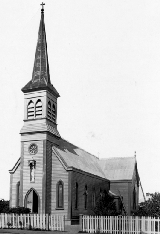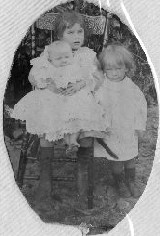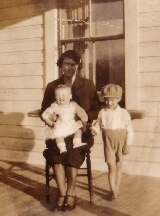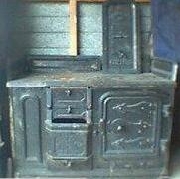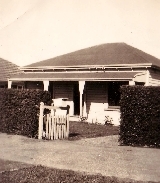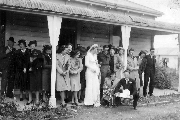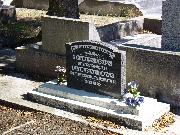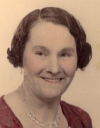
Catherine Potter
BORN: Masterton, 28 September 18861
DIED: Masterton, 9 May 19652
Biography:
At the time of Catherine's birth, the family was living in Kuripuni, at the south end of Masterton. In 1886 the family consisted of her parents, Anastasia and Albert and three older children. These were Mary (aged 9) and two older brothers, Albert (7) and Jim (3). The family had recently moved from Blenheim where Anastasia and Albert had been married. We don't know what prompted them to move to Masterton, but Albert may have been in search of work.
The 1880s in New Zealand was a period of severe economic depression and employment was scarce. We know that Albert also found it difficult to get work and he probably joined other itinerant labourers moving from farm to farm on the chance of picking up casual work. Family stories relate that he spent some time working at Glenburn sheep station. It is highly probable that his wages were both irregular and low, and that he was forced to spend considerable time away from home. In 1892, however, he was working for the Wairarapa North County Council. Nevertheless, it seems that his wages were not going to the family and Anastasia and the children became dependent on the charity of the North Wairarapa Benevolent Society. Anastasia took Albert to court a number of times between 1892 and 1896 in an in an effort to compel him to provide maintenance for his family. Despite threats of imprisonment by the Magistrate, it seems as though Albert didn't pay. It is also highly unlikely that he was living with his family by this time, so that Anastasia was forced to struggle on, bringing up six children on her own3.
From the start of their marriage in Blenheim, Anastasia's and Albert's relationship seems to have been a tempestuous one. It was a relationship that did not improve when faced with the challenges of unemployment and poverty in Masterton, and some time around 1897 Albert left his family for good. Family stories relate that he enlisted for the Boer War and Catherine used to sing a song about her father going to the war. However, there is no evidence that he did enlist and it is more likely that Anastasia used the story as a convenient way of explaining to the children their father's absence. It seems as though he eventually moved to Auckland where he married again. Catherine and the other children never saw him again and grew up both fatherless and in poverty.
We know very little of Catherine's early life after her father left but we can guess that a large part of her life (along with the rest of the family) revolved around the local Catholic community, church and school.
In the 1880s and 90s, the Catholic community in Masterton was very much an Irish community, centred around its energetic priest, Patrick Treacy and the school. Treacy, born in County Limerick and ordained in Waterford, arrived in Masterton in early 1884, to find the parish over £1000 in debt, with no Catholic school, and only a small bare cottage for his own use.4 By September, however, the first St Patrick's School had been built, funded by donations from the community, and Treacy was advertising for "a Female Catholic Teacher" 5. The school was situated behind the church in Queen Street, and soon had a roll of 70, with Mrs Carrick as the first school mistress. In 1884, Mary Potter would have been about seven so it's probable she was among the first children at the new school; in 1886 she was among the end-of-year prize winners, winning a prize for Chrstian Doctrine. Looking through the other prize-winners reveals a high proportion of Irish names: Ryan, Hourigan, O'Leary, Tierney, among others.6
Catherine would have started school a few years later, at the end of 1891 as soon as she had turned five, or at the beginning of the new school year in 1892. Children stayed at school untill the Seventh Standard, the equivalent of today's Year 8 at about the age of 12 or 13. Most didn't go on to high school. Both Mary and Albert may have left school by the time Catherine begun, but certainly brother Jim was there with her since a report in the Wairarapa Times in 1894 stated he had passed the Third Standard.7
In 1898, when Catherine was in the Sixth Standard, instruction in the school was taken over by sisters of the Congregation of St Brigid. They had come from Australia at the encouragement of the parish priest, John McKenna. 8 Fr. McKenna had come to Masterton in 1887 and remained the parish priest until his death in 1930.9 He was an able adminstrator and pastoral priest, but probably more importantly for Anastasia and the family, he was a fellow native of Kilkenny. He would have been a frequent visitor to the house and a great source of comfort for Anastasia.
None of Catherine's school reports have come to light, so we don't know how well she did. However, she was almost expelled for unladylike behaviour when she booted back a ball that had strayed from the boys' play area. Only the angry intervention of her mother, supported by Fr. McKenna, saved the day and prevented a premature end to Catherine's school career.10 The intolerance of this sort of wild behaviour and the response to it seems rather surprising to us today, but reminds us of the radically different definitions of feminity that prevailed at the time.
In February 1899 the St Bride's Boarding and Day High School was opened across the road from the Church11. At the same time, St Patrick's School was relocated across the road near the new convent. Catherine spent her last year at the new school and left at the end of the Seventh Standard. The family's financial situation meant she couldn't afford to attend the new St Bride's School. She worked at various jobs to earn money for the family, including work at the Midland Hotel as a housemaid for a time.
We don't have any details of how Catherine and Charles met, but there was a considerable amount of opposition from Anastasia towards the relationship, although the reasons are not entirely clear. There was a considerable difference in age; Charles was almost nine years older. Moreover, Catherine was Catholic and Charles was Church of England in the days when mixed religious marriages were often actively discouraged. Whatever the reason, Anastasia refused Catherine permission to marry even after the birth of their first child, Anastasia Marjorie (Madge) in 1906. It seems as though both Catherine and the baby continued to live with Anasatsia. However, Catherine soon became pregnant again. When Anastasia continued to oppose their marriage, Catherine and Charles appealed to the Magistrate's Court for permission to marry.12 Permission was granted and they were finally married on November 8th, 1906 at St Patrick's Church.13 However, even then the atmosphere of disapproval continued and instead of being married in the church proper, they were married in the sacristy at the rear of the church.14
Their second child was born in 1907 and christened Catherine Norah. Sadly she died about a year after her birth. Following this tragedy was the birth of their first son Charles James (Jimmy) in 1909 and then Clara Ethel Norah (Effie) in 1910. Again tragedy struck and Effie drowned when only 8 months old. Photo 3 shows Madge, Jimmy and Effie in 1910. Catherine had nine more children. All survived except Dulcie who died in 1927, only 8 years old, and Joseph who died in 1925, just hours after birth. Photo 4 shows the family (all except the two youngest, Denis and Joan) in about 1924.
After their marriage they lived in Featherston and then at Rangitumau about 20km north of Masterton, where Charles worked on farms. Thereafter they moved back to Masterton and lived in various houses, in Church Street, Roberts Road, in Lincoln Road with Anastasia, in the Central Hotel for a while, and Railway Road (now Ngaumatawa Road).15 They then bought their first house in Sussex Street where they lived untill early in 1927 when they bought the house at 87 Cornwall Street.16
They remained in the Cornwall Street house for the rest of their lives and it became the centre of family life, not just for Catherine's children, but for her grandchildren and great grandchildren untill her death in 1965.
The house was wooden, with three-bedrooms that today hardly seems big enough to have accomodated everybody. There was a front room, with the best furniture and a fine gramaphone, that was used to receive and entertain guests, but hardly used otherwise. When the priest visited, this is where he was taken and given a cup of tea. Charles and Catherine had their own bedroom, but the children made the best use of bunks and double beds in the other two rooms. The real centre of the house, where the family spent most of their time together, was the kitchen at the back with its coal range that was kept burning throughout the day. On cold days the heat would be cranked up, and with a large number of people packed into a small room, could be somwhat overbearing. Photo 6 shows a coal range similar to the one Catherine used. The following photos (7 and 8) show the front of the house and the house on the day of Joyce's wedding to Bill Teahan in 1944.
Running a large household in the early 1900s was certainly a full-time job. Catherine was an excellent cook, all done on her coal range. Feeding the large numbers of children coming and going was a full-time job in itself, but Catherine also made her own soap and knitted jersys and cardigans for the children. Many were multi-cloured, since nothing went to waste, including left-over remnants of wool. The family leased land around the Masterton gas works where they had one or two milking cows. They were milked daily by one of the children and Catherine used the excess milk to make butter and sometime cheese which she sold. When her sons grew up she brewed beer for them. Behind the house in Cornwall Street was a half-acre section with vegetable gardens and fruit-trees so the family was largely self-sufficient. When Charles came home from work he would spend his time tending the gardens. Since very few people had cars they tended not to go to shops for groceries and meat, but would have them delivered to the house. Vendors of food and services, going from house to house with horse and cart, were a common sight. Thomas's Butchery delivered meat. A Chinese vegetable vendor named Humbug delivered vegetables they couldn't get from their own garden, and always stopped for a cup of tea. Washing before the age of washing-machines was an arduous and time-consuming chore. It took great effort to scrub clothes with soap on a wooden scrubbing board, light the copper to boil the clothes in soapy water, lift them out to rinse them in cold water and wring them out ready for drying. Most women dreaded this weekly wash day routine.17 A lot of the responsibility for helping around the house, as well as the care of the younger children, Denis and Joan, fell to Norma and Joyce.
Sunday was the day for Mass at St Patrick's church, although as an Anglican, Charles wouldn't attend. However, he always supported Catherine and expected the children to attend. As the boys grew older any attempt to skip Mass would be met with a stern reprimand from their father. When Nicholas Moore replaced John McKenna as Parish priest in 1930, they became good friends. Both were fans of the author Zane Grey and swapped his books with each other.
Father Moore's arrival in Masterton coincided with the Great Depression. However, Charles worked throughout, at the Masterton Gas Works, and the family managed relatively well during those difficult days. Charles's father Daniel had been living in England sonce 1900. Despite the long separation, the family received money from Daniel's estate sometime after his death in 1930. With this money Charles and Catherine bought their first car, an Austin 12. Not many people owned cars in those days and they must have felt quite grand. On Sundays, Charles drove Catherine to Mass, but as usual would not attend himself. Instead he often bought the sports paper and read it in the car untill Catherine was ready to return home.
Catherine had auburn hair, which she inherited from her father. He had "red" hair as did Albert's sisters Elizabeth and Ruth. As Catherine grew older the colour darkened and eventually turned to black. She didn't begin to turn grey untill she was in her late forties, but turning grey must have been a concern for her because Denis and Joan were asked to pick out any grey hairs and were given a penny for any they removed.
At the beginning of the 1940s Joyce, Patsy, Joan and Denis were still living at home. These were very difficult years for Catherine and the family. Charles was diagnosed with cancer in about 1940 and during the early part of 1942 he became seriously ill. As his condition worsened he moved into a bed of his own in the boys' room, which he now shared with Denis. The District Nurse called in daily to tend to him and give him pain-killing injections. He died on the 3rd September 1942.18
Along with the loss of a husband and father, the family had to contend with the heartbreak and uncertainty of loved ones going to war. Paddy was the only boy of the family called up for service, enlisting in the navy in 1941. Bill Teahan had been dating Joyce for about a year before he was called up in September 1941. They got engaged just before he was sent to Fiji in 1942 with the New Zealand 3rd Division. Both Paddy and Bill survived the war, but Patsy's fiance, Mervyn Harris was killed in northern Italy in April 1943.
Even at home, unexpected events put the family in danger. In the evening of the 24th June 1942, a massive earthquake hit Masterton and the Wairarapa district, causing widespread damage to buildings in the area, although there were no fatalities. There was a tremor about 8.15pm, followed by the main earthquake a few hours later. At the time of the initial tremor Denis recalls he was playing pool at the St Patrick's school hall, which had been opened up as a recreation centre for servicemen and Joyce recalled being in the Regent Theatre. The two chimineys at 87 Cornwall Street were badly cracked. At the beginning of 1943 Denis was working as an electrician at the Japanese prisoner of war camp in Featherston. Despite tensions between the prisoners and guards, Denis recalls that there were generally good relationships between the prisoners and the electricians. One day in February they were discretely warned by one of the prisoners not to come to the camp the next day. The "next day", the 25th February, began with some 240 of the prisoners refusing to parade for work, and ended with a riot in which 48 Japanese and one guard were killed.19 Without the timely warning of one of the prisoners they had befriended, Denis and his work mates might also have got caught up in the affair.
After the war, Catherine and 87 Cornwall Street continued as the centre of family activity, but by the early 1960s her health began to deteriorate untill she was unable to live on her own. For various periods she lived with members of the family who were living in Masterton: mostly with Joyce and Bill, but also with Norma, Denis and Joan. The burden of caring for Catherine seems to have put considerable pressure on the various families and there were disagreements about the sharing of the responsibility.20 A family conference was held and it was decided that Catherine, despite her disapproval, should be admitted to a private nursing home. Sadly, she wasn't treated well there and her health deteriorated further. She was admitted to the Masterton Public Hospital but didn't recover and died on Sunday, 9th May 1965.21
She is buried in Masterton cemetery next to her husband Charles.
References:
- Birth Certificate for Catherine Potter
- Death Certificate for Catherine Potter
- For more details refer to Anastasia's biography
- New Zealand Tablet, 24 October 1884, p15
- New Zealand Tablet, 12 September 1884
- Wairarapa Star, 21 December 1886. Also New Zealand Tablet, 31 December 1886, p7
- Wairarapa Times, 8 December 1894. Also New Zealand Tablet, 28 December 1884, p27
- The story of the nuns' arrival in Masterton is given in more detail in the Brigidine Sisters website.
- ibid.
Also Dictionary of New Zealand Biography- Story related by Denis Cross
- Brigidine Sisters website.
The laying of the foundation stone for the new convent was given extensive coverage in the New Zealand Tablet, 3 June 1898, p31. This article, and other New Zealand Tablet articles, is available online at Papers Past- Story related by Denis Cross.
- NZ Internal Affairs BDM, Record no: 1906/7535
- Story related by Denis Cross.
The sacristy is a small room, typically at the rear of the church behind the altar, where the vestments, church furnishings and sacred vessels are kept, and where the clergy meet and dress for ecclesiastical functions. The sacristy is not blessed or consecrated and consequently is not considered a sacred place.- Teahan, W. J., Biography: Margaret Joyce Teahan. p9.
Bill Teahan's biography of his wife Joyce has been invaluable for giving an "outsider's" perspective on the Cross family. A number of details, especially those relating to Bill and Joyce, have been taken from here.- Story related by Denis Cross
- These stories were related by Denis Cross.
Children raised in the 21st Century have little idea of how radically different life was at the beginning of the 20th Century, without refrigeration, washing machines, cars, or any of the other devices we now take for granted. There seem to be very few good descriptions of the details of family life at this time. One interesting source of information is Otago University's description of life in Dunedin between 1890 and 1940, The Caversham Project- The cause of death given on Charles's death certificate is "Carcinoma of Colon".
- Read more about the riot here.
- See Teahan, W. J., ibid. pp96-8.
- The cause of death given on Catherine's death certificate is "Carcinoma of Breast".

